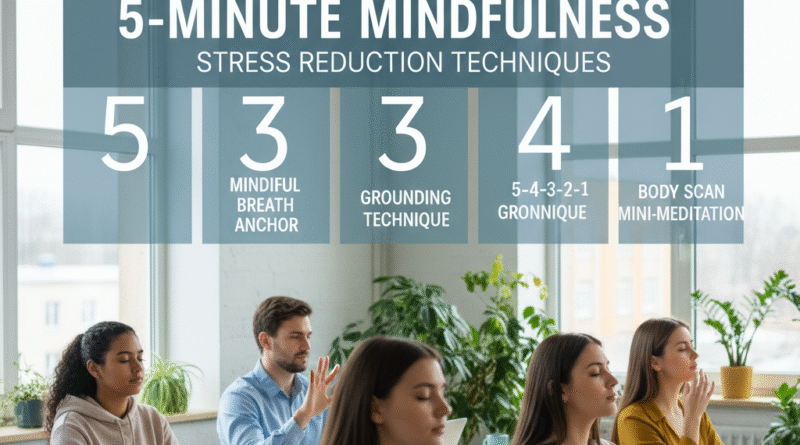5 Minute Mindfulness Stress Reduction
5 Minute Mindfulness Stress Reduction: Quick Exercises for Anxiety & Focus
Introduction: Reclaiming Your Calm in Just 5 Minutes
Do you ever feel like you are running on empty? Life today often moves at a frantic pace. Therefore, managing stress and anxiety has become a critical skill for everyone, especially for busy students and professionals. 5 minute mindfulness stress reduction offers a powerful, practical solution to this modern dilemma. Moreover, you absolutely do not need hours of quiet time to reap the significant benefits of mindfulness. Consequently, this article outlines quick, practical mindfulness exercises and techniques that you can easily incorporate into your busy daily schedule to manage anxiety and improve focus. Furthermore, these techniques are simple, effective, and require no special equipment, making them perfect for on-the-go mental health breaks.
The Power of the Pause: Why 5 Minutes is Enough
A common misconception is that effective stress relief requires a huge time commitment. However, that is simply not true. Instead, short, intentional bursts of 5 minute mindfulness stress reduction can reset your nervous system. In addition, these brief moments train your brain to stay present, which is the very foundation of mindfulness. Consequently, consistent, short practices often prove more sustainable than trying to schedule an hour of meditation once a week. Moreover, by integrating these techniques, you quickly interrupt the stress response cycle, stopping anxious thoughts before they spiral out of control. Furthermore, a momentary pause can dramatically enhance your mental clarity and ability to concentrate on tasks.
Essential 5-Minute Mindfulness Exercises
Implementing quick, practical mindfulness exercises is straightforward and highly effective. Therefore, let’s explore three of the most powerful and easy-to-use techniques you can deploy anytime, anywhere.
The Mindful Breath Anchor
Deep breathing is perhaps the simplest and most accessible form of instant stress relief. Nevertheless, most people do not breathe deeply enough to fully calm their system. Therefore, focus on making your exhale longer than your inhale to activate the body’s natural calming mechanism, known as the parasympathetic nervous system.
The Technique:
- First, find a comfortable seat and close your eyes, or simply soften your gaze.
- Next, inhale slowly and deeply through your nose for a count of four.
- Then, hold your breath gently for a count of two.
- Finally, exhale slowly through your mouth for a count of six, letting all the tension go.
- Moreover, continue this cycle for the full five minutes, always returning your focus to the sensation of the air moving in and out.
- Therefore, this simple practice instantly helps to manage anxiety and reduce stress.
The 5-4-3-2-1 Grounding Technique
This technique is a fantastic tool for quickly pulling your mind out of worry or rumination. Furthermore, this method uses your five senses to anchor you firmly in the present moment, stopping the mental chatter.
The Technique:
- To start, notice 5 things you can see around you—a pencil, a shadow, a spot on the wall.
- Next, acknowledge 4 things you can feel—the texture of your clothes, your feet on the floor, the air on your skin.
- Then, listen for 3 things you can hear—a distant siren, the hum of a computer, your own breath.
- Subsequently, identify 2 things you can smell—your coffee, your hand soap, or just the air itself.
- Finally, recognize 1 thing you can taste—the residual flavor of your last drink or meal.
- Therefore, actively engaging all your senses is an excellent way to improve focus and achieve quick stress reduction.
The Body Scan Mini-Meditation
The body scan is a powerful practice that releases physical tension you may not even realize you are holding. Conversely, unchecked physical tension significantly contributes to increased stress.
The Technique:
- First, take a moment to sit comfortably, adopting a stable posture.
- Next, bring your attention to your toes and simply notice any sensations there.
- Subsequently, slowly move your awareness up your body—to your ankles, shins, knees, and so on.
- Moreover, pay special attention to areas like your shoulders, jaw, and forehead, which often harbor tension.
- When you find tension, simply breathe into that area and imagine it softening as you exhale.
- Therefore, continue this mindful scanning for five minutes until you reach the top of your head.
- In conclusion, this systematic approach to body awareness provides rapid relief from the physical symptoms of stress.
Incorporating Mindfulness into Your Busy Routine
You need to strategically integrate these short exercises into your daily life to make mindfulness a habit. Furthermore, think of these moments as micro-breaks for your mind.
Perfect Times for a Mindful Break
Identifying trigger points in your day for a quick practice is key to long-term success. For example, the few minutes right before a challenging meeting are ideal for a mindful breath anchor. Likewise, try a quick body scan while you wait for your computer to load. Moreover, another great opportunity is the minute before you open a textbook or start studying, which is perfect to improve focus. Therefore, use transitional moments, such as waiting in line or commuting, to practice a quick five-minute exercise. Consequently, these small shifts transform otherwise ‘dead’ time into valuable moments of self-care and stress management.
Making the Habit Stick
Consistency is far more important than intensity when building any new habit. Therefore, you should commit to one 5 minute mindfulness stress reduction session every day, even if it feels awkward at first. Moreover, pair the practice with an existing habit, such as your morning coffee or right after you brush your teeth. As a result, this technique, called ‘habit stacking,’ makes the new routine much easier to remember and maintain. Furthermore, remember to approach your practice with kindness and non-judgment. Therefore, if your mind wanders (and it will!), simply notice the thought and gently guide your attention back to your chosen anchor, such as your breath.
A Quick Path to Lasting Calm
You hold the power to significantly reduce stress and enhance your overall well-being. By dedicating just five minutes a day to these practical mindfulness exercises, you take a proactive step toward a calmer, more focused life. Therefore, begin today by choosing one of the exercises and setting a timer. Moreover, embrace this quick path to lasting calm and discover how truly impactful a small commitment to 5 minute mindfulness stress reduction can be. In the long run, this investment in your mental health will pay dividends in every aspect of your life.




